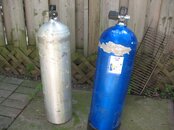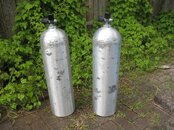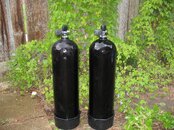I had a couple of tanks handed down to me that were pretty beat up. I looked at having them repainted or just leaving them stripped down to the bare aluminum. Then I remembered that my wife worked for a company that anodizes aluminum. Spoke to the owner and to a tech guy at Catalina and came up with a plan.
First I stripped them using a paint stripper I bought at Home Depot. Took about 1 hour to strip them both. I lightly sanded areas that had corrosion built up...which covered about 10% of each tanks surface. I used 600 grit sandpaper and sanded until smooth.
I had the tanks empied and valves removed...plugged the holes with plastic plugs from LDS.
I dropped the tanks off at the anodizers, and decided to go with recommended black. Because of the previous corrosion on exterior of tank, it left "scarring" or marks on the surface which would be visible after the process was completed. I could have sanded the marks down so you could no longer see them, but I wasn't interested in reducing the thickness of my tanks walls. Rather have tanks with a few small marks than a tank that fails a Hydro.
Anyway, I just got my tanks back, and I'm pretty happy with them. With the new finish you can scratch a key on the tank and it will not leave a mark. It's very hard.
All it cost me was a bottle of paint stripper ($7.00) and a $25.00 donation to a charity the company is raising money for. Pretty Sweet Deal!!!
Attached some pics for those who are interested. I wasn't sure how this project would turn out, but I'm happy and learned a lot in the process. Hope you enjoy.
First I stripped them using a paint stripper I bought at Home Depot. Took about 1 hour to strip them both. I lightly sanded areas that had corrosion built up...which covered about 10% of each tanks surface. I used 600 grit sandpaper and sanded until smooth.
I had the tanks empied and valves removed...plugged the holes with plastic plugs from LDS.
I dropped the tanks off at the anodizers, and decided to go with recommended black. Because of the previous corrosion on exterior of tank, it left "scarring" or marks on the surface which would be visible after the process was completed. I could have sanded the marks down so you could no longer see them, but I wasn't interested in reducing the thickness of my tanks walls. Rather have tanks with a few small marks than a tank that fails a Hydro.
Anyway, I just got my tanks back, and I'm pretty happy with them. With the new finish you can scratch a key on the tank and it will not leave a mark. It's very hard.
All it cost me was a bottle of paint stripper ($7.00) and a $25.00 donation to a charity the company is raising money for. Pretty Sweet Deal!!!
Attached some pics for those who are interested. I wasn't sure how this project would turn out, but I'm happy and learned a lot in the process. Hope you enjoy.






